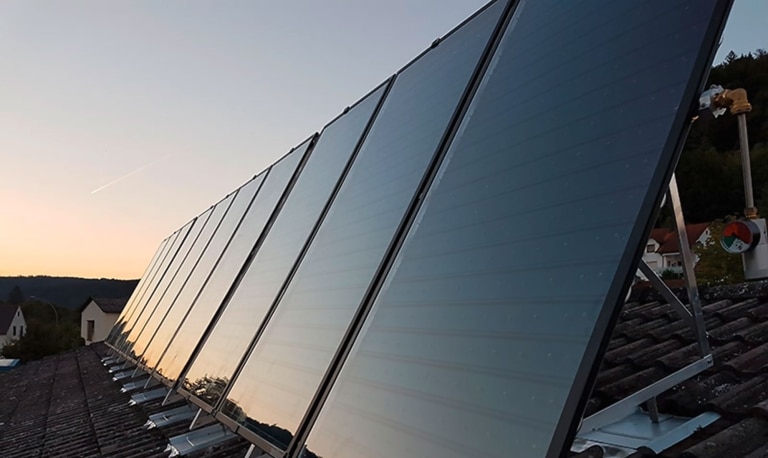Heating with solar technology in winter
It’s a well-established fact that thermal solar systems can effectively support heating and hot water production. Combining a biomass heating system with solar panels, for example, unlocks a wealth of environmental and economic benefits, creating a hybrid heating system that’s hard to beat.
The benefits are particularly evident during the sun-drenched summer months. But what about the relatively sunless winter months? It’s actually possible and sensible to use solar technology for heating in the winter too. However, in order to maximise the free energy from the sun, a number of factors need to be taken into account.
Thermal solar energy: fundamentals in winter and summer
Solar systems can slash energy costs by up to 30 % when combined with existing heating and hot water systems. However, for optimal efficiency, careful planning and implementation are crucial. With the right strategy, solar heating can work effectively, even in the winter months.
Beyond the duration of sunshine, three key factors influence the yield and efficiency of a solar system: size, orientation, and tilt angle.
- Size: The general rule is simple: the larger the solar surface, the higher the output.
- Orientation: A south-facing position maximizes sunlight capture. However, east or west orientations can also offer advantages for generating energy in the morning or evening, respectively. Naturally, any structural or natural obstacles that cast shadows on the panels must be avoided.
- Tilt angle: Optimizing the tilt angle of the solar collectors is a bit more complex. The ideal angle varies depending on the season and the specific solar position.

Getting your solar system ready for winter
While the sun basks high in the summer sky, it dips considerably lower during the colder months, even at midday. This shift in solar position necessitates a corresponding adjustment in the ideal tilt angle of a solar installation during the winter season.
While a tilt of 40 degrees is considered optimal for the summer months, a steeper angle of 70 degrees maximises energy output between October and March. Although this might result in less energy production from April to September, it can still be a worthwhile strategy year-round. This is because thermal solar energy is primarily utilised to supplement the heating system, and heat demand is significantly higher during the cold months, while summer often brings an energy surplus.

Snow & cold: a threat to a thermal solar system?
How does solar energy fare in cold temperatures and snow? Can winter’s chill and snow pose a threat to your solar system?
To prevent freezing and potential damage even at extremely low temperatures, modern solar collectors employ a blend of water and antifreeze as the heat transfer fluid. Even if snow accumulates on the collector’s surface, it’s generally not cause for alarm. While snow does diminish energy production, the orientation and inclination of the collectors ensure that the snow melts and slides off as quickly as possible.
Hargassner thermal solar systems are, incidentally, equipped with hail-resistant glass covers, making them exceptionally durable. For particularly snowy regions, a collector of the HSL variants designed for increased snow load is recommended. With these safeguards in place, eco-friendly heating remains a viable option even in the depths of winter.
Discover the modern products from Hargassner, your heating technology experts from Austria, and get advice from one of our many partners!

